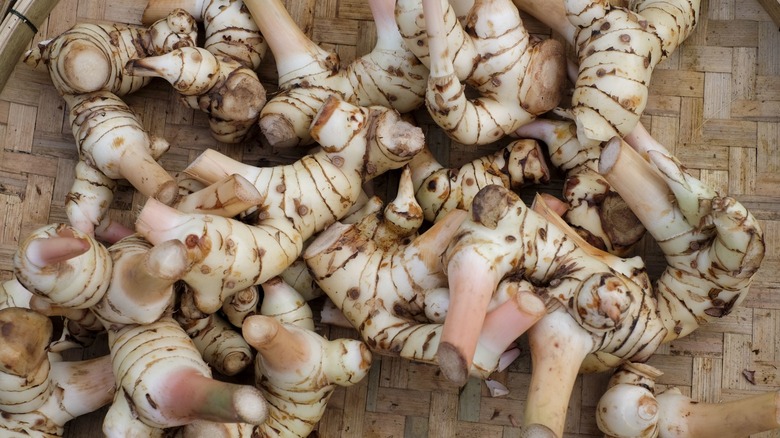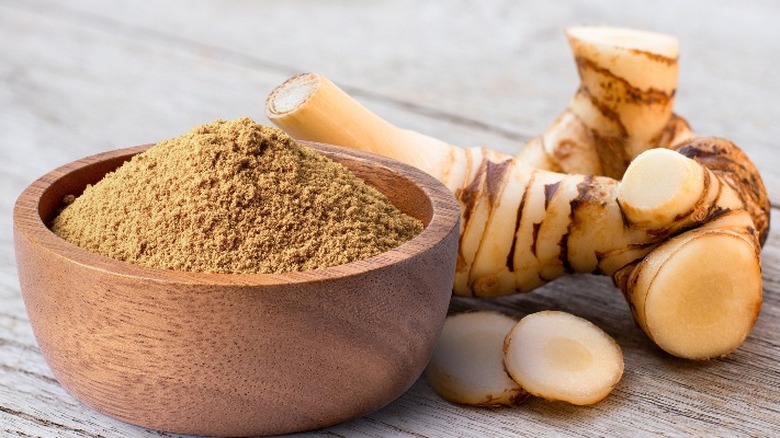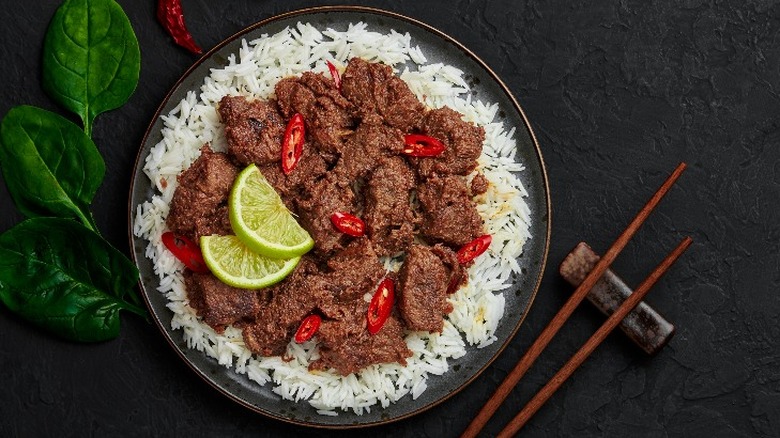What Is Galangal And How Do You Use It?
If you've ever eaten Thai food, you're familiar with the complex flavor palette of spicy and sweet that's the result of its diverse array of herbs and spices. One of the most essential of these flavorings is galangal, a root vegetable similar to but certainly not identical to ginger. Although both have a spicy, peppery bite, galangal provides a citrus flavor that many describe as "piney," while ginger tends to be more earthier and mellowed-out. Galangal is also tougher than ginger, which tends to become smooth and tender as you cook it.
Both of these ingredients come from the part of a plant known as a rhizome, meaning they're technically stems (not roots) that grow horizontally underground. Turmeric, which also looks similar to ginger and galangal but has the most bitter flavor of all three of them, is also included in this group. Besides adding an earthy flavor and aroma to dishes, rhizomes are valued for their anti-inflammatory, possibly disease-fighting health benefits.
How to cook with galangal
There are two distinct types of galangal. The sort that's primarily found in Thai food and other Southeast Asian cuisine is greater galangal, while the misleadingly named lesser galangal from southern China actually has a more intense flavor and more medicinal applications. Fingerroot is also commonly and confusingly called lesser galangal, although it's technically an entirely different rhizome species.
Like ginger, galangal is available in fresh form, ground, as a powdered spice, and as a paste. It's a bit harder to find than ginger, but if you don't have an Asian market nearby, you can always order it online from Amazon or other websites like Umamicart. You can slice fresh galangal and throw it into whatever you're cooking, but since galangal is tougher than ginger you should toss it out when you're finished, much like you would a cinnamon stick or bay leaf. You can mince galangal, as well, but the best method to ensure a smoother texture is grinding it up.
Recipes for galangal
Galangal is a very flexible ingredient; it can become a key part of a whole host of different dishes, depending on the way it's prepared. Sliced galangal is best for curries, soups, and stews, while you'll probably want to grate or grind before adding it to less liquid-heavy recipes like stir-fries. Powdered galangal also makes for a nice seafood seasoning, since its earthy notes can counter-balance fishy flavors.
Due to its versatility, galangal is found throughout Malaysian, Thai, Indonesian, Vietnamese, and Cambodian cooking. The cool-yet-spicy flavor of tom kha and tom yum soup is a signature example of the way galangal shines. The root also makes for a wonderful addition to peanut sauces, like you'd have with chicken satay or the Khmer sach ko ang, and it stars as part of the thick, curry-like beef rendang, a staple of Indonesian and Malay cuisine. Recipes may sometimes suggest you can substitute ginger, but there's really no alternative to galangal's piney, zesty goodness.



